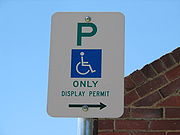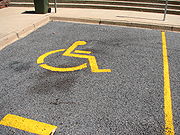
Disabled parking permit
Encyclopedia


European Union
The European Union is an economic and political union of 27 independent member states which are located primarily in Europe. The EU traces its origins from the European Coal and Steel Community and the European Economic Community , formed by six countries in 1958...
, is displayed upon parking a vehicle carrying a person whose mobility would be otherwise significantly impaired by one or more of age, illness, disability or infirmity. The permit allows exemption from street-parking charges in some places and is used to park within dedicated disabled parking spaces reserved for people who have satisfied requirements to receive the placard.
European Union
In the European Union (EU), a disabled parking permit allows partial or total exemption from charges or penalties associated with the parking of a motor vehicle used by a badge-holder, and shows entitlement to use of dedicated parking bays and off-street parking (where they are provided). The concession extends in some places to partial or total exemption from tolls or general prohibitions on where a vehicle can be driven. Since 2000, all general disabled parking permits in the EU have been standardised to a common style and blue colour, leading to the officially-used designation "Blue Badge". A Blue Badge issued in one country of the EU is generally given equal recognition in others with various exceptions as described for the countries below.Denmark
A Disabled Person's Parking Disk (also known as a "Clock") is required in addition to a Blue Badge in some parking places.Republic of Ireland
Disabled Persons' Parking Permits are issued by the Disabled Drivers Association of Ireland; an application fee of 25 Euro is required. The scheme and its application in Ireland are described on the Citizens Information website.United Kingdom
In the United KingdomUnited Kingdom
The United Kingdom of Great Britain and Northern IrelandIn the United Kingdom and Dependencies, other languages have been officially recognised as legitimate autochthonous languages under the European Charter for Regional or Minority Languages...
(UK), this scheme of permits was originally introduced (using Orange Badges) by the Chronically Sick and Disabled Persons Act 1970.
Badges are issued as a right if a person meets certain statutory requirements, most of which are associated with actually being in receipt of certain disability benefits from the national Social Security
National Insurance
National Insurance in the United Kingdom was initially a contributory system of insurance against illness and unemployment, and later also provided retirement pensions and other benefits...
system; additionally, a local authority can make concessionary issues of badges to persons who have a permanent disability which does not fall directly within the more rigid statutory requirements but which seriously impairs their mobility.
General exceptions
The Great Britain
Great Britain
Great Britain or Britain is an island situated to the northwest of Continental Europe. It is the ninth largest island in the world, and the largest European island, as well as the largest of the British Isles...
(GB) Blue Badge scheme does not apply to parking away from public roads and local authority car parks, with the general concessions often not recognised at ports, airports and railway stations unless the operators have provided voluntary parking privileges.
Parking Maps
Until 2010 Directgov provided a service that covers country wide customised maps for Blue Badge Holders with different base colours reflecting councils policies on Blue Badge Holder's parking. In addition to council policies this service also pin pointed the location of different features specific to disabled community. There are a few dedicated Blue Badge sat-navs available, mainly from the specialist sat-nav
Global Positioning System
The Global Positioning System is a space-based global navigation satellite system that provides location and time information in all weather, anywhere on or near the Earth, where there is an unobstructed line of sight to four or more GPS satellites...
company Navevo. See BBNav publicity for a likely list of integral features.
England and Wales
In England and WalesEngland and Wales
England and Wales is a jurisdiction within the United Kingdom. It consists of England and Wales, two of the four countries of the United Kingdom...
Blue Badge holders are required (unless signs show otherwise) to display a Disabled Person's Parking Disk
Disc parking
Disc parking is a system of allowing time-restricted free parking through display of a parking disc or clock disc showing the time at which the vehicle was parked. A patrolling parking attendant can inspect the disc to check whether payment is owed...
("Clock") showing the time the vehicle was first parked so that a time limit can be enforced. Badge holders from elsewhere in the European Union will need to obtain a Clock (obtainable from their Issuing Office in the UK) to validate their badge otherwise the vehicle will be treated as if no badge was displayed.
Local differences in parking rules
In London
London
London is the capital city of :England and the :United Kingdom, the largest metropolitan area in the United Kingdom, and the largest urban zone in the European Union by most measures. Located on the River Thames, London has been a major settlement for two millennia, its history going back to its...
the volume of traffic has led to restrictions upon the national scheme in some areas with local colour schemes used to restrict standard concessions to local residents, for example the permits are green in Camden
London Borough of Camden
In 1801, the civil parishes that form the modern borough were already developed and had a total population of 96,795. This continued to rise swiftly throughout the 19th century, as the district became built up; reaching 270,197 in the middle of the century...
, white in Westminster
City of Westminster
The City of Westminster is a London borough occupying much of the central area of London, England, including most of the West End. It is located to the west of and adjoining the ancient City of London, directly to the east of the Royal Borough of Kensington and Chelsea, and its southern boundary...
, purple in Kensington and Chelsea
Royal Borough of Kensington and Chelsea
The Royal Borough of Kensington and Chelsea is a central London borough of Royal borough status. After the City of Westminster, it is the wealthiest borough in England....
, and red in the City of London
City of London
The City of London is a small area within Greater London, England. It is the historic core of London around which the modern conurbation grew and has held city status since time immemorial. The City’s boundaries have remained almost unchanged since the Middle Ages, and it is now only a tiny part of...
. In these cities and boroughs special rules and parking spaces are provided for Blue Badge holders.
Similar local schemes operate in other large towns or cities in the UK, for example Norwich operates a 'green badge scheme'.
Northern Ireland
The standard scheme only generally applies to on-street parking and is outlined on the Roads Service Northern Ireland website. A "White Badge" is required for access to Pedestrian Zones.Scotland
In ScotlandScotland
Scotland is a country that is part of the United Kingdom. Occupying the northern third of the island of Great Britain, it shares a border with England to the south and is bounded by the North Sea to the east, the Atlantic Ocean to the north and west, and the North Channel and Irish Sea to the...
a local authority Parking Attendant (in addition to police and traffic wardens) has the power to inspect a Blue Badge; failure to allow this inspection is an offence. There are also proposals to extend the issue of badges to small children and a wider range of (temporarily or permanently) disabled people.
United States
In the United States, reserved spaces are mandated by the Americans with Disabilities ActAmericans with Disabilities Act of 1990
The Americans with Disabilities Act of 1990 is a law that was enacted by the U.S. Congress in 1990. It was signed into law on July 26, 1990, by President George H. W. Bush, and later amended with changes effective January 1, 2009....
Accessibility Guidelines.
Disabled parking permits generally take the form of either specially marked license plates or a placard that hangs from the rear-view mirror. Plates are generally used for disabled drivers on their personal vehicle, while the portable placard can be moved from one vehicle to another with the disabled person, both when driving or when being transported by another driver.
The medical requirements to obtain a permit vary by state, but usually are confined to specific types of disabilities or conditions. These as a general rule include the use of any assistive device such as a wheelchair, crutches, or cane, as well as a missing leg or foot. Many states also include certain cardiovascular conditions, respiratory problems, and conditions that cause pain while ambulating or otherwise require the person to rest after walking a very short distance. About half of US states (26) include blindness as a disability that can obtain a placard (for use as a passenger) and 14 states include a missing or maimed hand. Four states include deafness, and only two states (Virginia and New York) include mental illness or developmental disabilities
Autism
Autism is a disorder of neural development characterized by impaired social interaction and communication, and by restricted and repetitive behavior. These signs all begin before a child is three years old. Autism affects information processing in the brain by altering how nerve cells and their...
.
Most if not all states have blue permits for people with lasting or permanent disabilities, and temporary permits that are red or another color for short term conditions such as broken legs or recovering from surgery.
The availability of specially reserved parking spaces is regulated by both federal and state laws. Generally at least one space is available at any public parking location, with more being required based on the size of the parking lot and in some cases the type of location, such as a health care facility. Parking spaces reserved for the disabled are typically marked with the International Symbol of Access
International Symbol of Access
The International Symbol of Access , also known as the Wheelchair Symbol, consists of a blue square overlaid in white with a stylized image of a person using a wheelchair...
, though in practice, the design of the symbol varies widely. Anyone parking in such reserved spaces must have their plate or mirror placard displayed, or else the car can be ticketed for illegal parking. In some major US cities, local law also allows such vehicles to park for free at city parking meters and also exempts from time limits on time parked. Fraudulent use of another person's permit is heavily fined.
If traveling from other countries, requirements to obtain a parking permit vary from state to state. Some states will honour other country permits, while others require application as a visitor/tourist.

